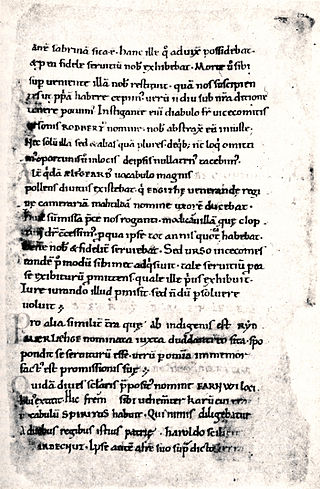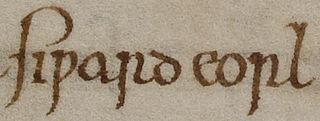Related Research Articles
Godwin of Wessex was an English nobleman who became one of the most powerful earls in England under the Danish king Cnut the Great and his successors. Cnut made Godwin the first Earl of Wessex. Godwin was the father of King Harold II and of Edith of Wessex, who in 1045 married King Edward the Confessor.
Tostig Godwinson was an Anglo-Saxon Earl of Northumbria and brother of King Harold Godwinson. After being exiled by his brother, Tostig supported the Norwegian king Harald Hardrada's invasion of England, and was killed alongside Hardrada at the Battle of Stamford Bridge in 1066.
Waltheof, Earl of Northumbria was the last of the Anglo-Saxon earls and the only English aristocrat to be executed during the reign of William I.

Ealdorman was a term in Anglo-Saxon England which originally applied to a man of high status, including some of royal birth, whose authority was independent of the king. It evolved in meaning and, in the eighth century, was sometimes applied to the former kings of territories which had submitted to great powers, such as Mercia. In Wessex in the second half of the ninth century, it meant the leaders of individual shires appointed by the king. By the tenth century, ealdormen had become the local representatives of the West Saxon king of England. Ealdormen would lead in battle, preside over courts, and levy taxation. Ealdormanries were the most prestigious royal appointments, the possession of noble families, and semi-independent rulers. Their territories became large, often covering former kingdoms, such as Mercia or East Anglia. Southern ealdormen often attended court, reflecting increasing centralisation of the kingdom, but the loyalty of northern ealdormen was more uncertain. In the eleventh century, the term eorl, today's earl, replaced that of ealdorman, but this reflected a change in terminology under Danish influence rather than a change in function.

Eadric Streona was Ealdorman of Mercia from 1007 until he was killed by King Cnut. Eadric was given the epithet "Streona" in Hemming's Cartulary because he appropriated church land and funds for himself. Eadric became infamous in the Middle Ages because of his traitorous actions during the Danish re-conquest of England.

Siward or Sigurd was an important earl of 11th-century northern England. The Old Norse nickname Digri and its Latin translation Grossus are given to him by near-contemporary texts. It is possible Siward may have been of Scandinavian or Anglo-Scandinavian origin, perhaps a relative of Earl Ulf, although this is speculative. He emerged as a regional strongman in England during the reign of Cnut. Cnut was a Scandinavian ruler who conquered most of England in the 1010s, and Siward was one of many Scandinavians who came to England in the aftermath, rising to become sub-ruler of most of northern England. From 1033 at the latest, he was in control of southern Northumbria, present-day Yorkshire, governing as earl on Cnut's behalf.
Morcar was the son of Ælfgār and brother of Ēadwine. He was the earl of Northumbria from 1065 to 1066, when William the Conqueror replaced him with Copsi.
Earl of Northumbria or Ealdorman of Northumbria was a title in the late Anglo-Saxon, Anglo-Scandinavian and early Anglo-Norman period in England. The ealdordom was a successor of the Norse Kingdom of York. In the seventh century, the Anglo-Saxon kingdoms of Bernicia and Deira were united in the kingdom of Northumbria, but this was destroyed by the Vikings in 867. Southern Northumbria, the former Deira, then became the Viking kingdom of York, while the rulers of Bamburgh commanded territory roughly equivalent to the northern kingdom of Bernicia. In 1006 Uhtred the Bold, ruler of Bamburgh, by command of Æthelred the Unready became ealdorman in the south, temporarily re-uniting much of the area of Northumbria into a single jurisdiction. Uhtred was murdered in 1016, and Cnut then appointed Eric of Hlathir ealdorman at York, but Uhtred's dynasty held onto Bamburgh. After the Norman Conquest the region was divided into multiple smaller baronies, one of which was the earldom of Northumberland, with others like the earldoms of York and numerous autonomous liberties such as the County Palatine of Durham and Liberty of Tynedale.
Osulf or Oswulf was the son of Eadwulf IV, Earl of Bamburgh, and grandson of Uhtred the Bold, ruler of Bamburgh and ealdorman of Northumbria. Oswulf’s family ruled Bamburgh from 954 until 1041, though their independence may have been compromised after 1041 when Siward the Stout killed Eadwulf and gained hegemony over the north.
Eadulf IV or Eadwulf IV was the earl of Bernicia from 1038 until his death. He was a son of Uhtred the Bold and his second wife Sige, daughter of Styr Ulfsson. Eadwulf had one full sibling, a younger brother Gospatric. He succeeded his older half-brother Ealdred, who was murdered by the son of Thurbrand the Hold in a bloodfeud started when Thurbrand murdered Uhtred. The Anglo-Saxon Chronicle asserts that in 1041 Eadwulf was "betrayed" by King Harthacnut. The "betrayal" seems to have been carried out by Siward, Earl of Northumbria; When the Libellus de Exordio and other sources write about the same event, they say that Siward attacked and killed Eadulf. Siward then became earl of all Northumbria, perhaps the first person to do so since Uhtred the Bold. Eadulf was the last of the ancient Bernician line of earls to rule, until his son Osulf usurped the Northumbrian earldom in 1067.
Uhtred of Bamburgh, was ruler of Bamburgh and from 1006 to 1016 the ealdorman of Northumbria. He was the son of Waltheof I, ruler of Bamburgh (Bebbanburg), whose family the Eadwulfings had ruled the surrounding region for over a century. Uhtred's death by assassination was described in De obsessione Dunelmi and has been interpreted as the beginning of a blood feud. Not to be confused with Uhtred the son of Eadwulf I of Bamburgh, which is why he historically has been referred to as Uhtred the Bold.
Waltheof was high-reeve or ealdorman of Bamburgh. He was the son of Ealdred, and the grandson of Oswulf I and was father of Uhtred the Bold, Ealdorman of Northumbria. His name is Scandinavian which may imply that he had Viking ancestors.
The Earls of East Anglia were governors of East Anglia during the 11th century. The post was established by Cnut in 1017 and disappeared following Ralph Guader's participation in the failed Revolt of the Earls in 1075.

Oslac ealdorman of York from around 963 to 975. His territory included but may not have been limited to the southern half of Northumbria. His background is obscure because of poor source documentation. The latter has facilitated disagreement amongst historians regarding his family and ethnicity.
Thored was a 10th-century Ealdorman of York, ruler of the southern half of the old Kingdom of Northumbria on behalf of the king of England. He was the son of either Gunnar or Oslac, northern ealdormen. If he was the former, he may have attained adulthood by the 960s, when a man of his name raided Westmorland. Other potential appearances in the records are likewise uncertain until 979, the point from which Thored's period as ealdorman can be accurately dated.
Siward Barn was an 11th-century English thegn and landowner-warrior. He appears in the extant sources in the period following the Norman Conquest of England, joining the northern resistance to William the Conqueror by the end of the 1060s. Siward's resistance continued until his capture on the Isle of Ely alongside Æthelwine, Bishop of Durham, Earl Morcar, and Hereward as cited in the Anglo-Saxon Chronicle. Siward and his confiscated properties in central and northern England were mentioned in Domesday Book, and from this it is clear that he was one of the main antecessors of Henry de Ferrers, father of Robert de Ferrers, the first Earl of Derby.
Northman was a late 10th-century English earl, with a territorial base in Northumbria north of the River Tees. A figure with this name appears in two different strands of source material. These are, namely, a textual tradition from Durham witnessed by Historia de Sancto Cuthberto and by the Durham Liber Vitae; and the other an appearance in a witness list of a charter of King Æthelred II dated to 994. The latter is Northman's only appearance south of the Humber, and occurred the year after Northumbria was attacked by Vikings.
Ælfhelm was the ealdorman of Northumbria, in practice southern Northumbria, from about 994 until his death. An ealdorman was a senior nobleman who governed a province—a shire or group of shires—on behalf of the king. Ælfhelm's powerful and wealthy family came from Mercia, a territory and former kingdom incorporating most of central England, and he achieved his position despite being an outsider. Ælfhelm first appears in charters as dux ("ealdorman") in about 994.
Thurbrand, nicknamed "the Hold", was a Northumbrian magnate in the early 11th century. Perhaps based in Holderness and East Yorkshire, Thurbrand was recorded as the killer of Uhtred the Bold, Earl of Northumbria. The killing appears to have been part of the war between Sweyn Forkbeard and Cnut the Great against the English king Æthelred the Unready, Uhtred being the latter's chief Northumbrian supporter. Thurbrand may also have attested a charter of 1009 and given a horse to Æthelred's son Æthelstan Ætheling. The killing is the first-known act, if it did not initiate, a bloodfeud between Thurbrand's family and Uhtred going into the time of Earl Waltheof. It is possible that Holderness took its name because of Thurbrand's presence or ownership of the peninsula.
The Northumbrian Revolt of 1065 was a rebellion in the last months of the reign of Edward the Confessor against the earl of Northumbria, Tostig Godwinson, brother of Harold Godwinson, Earl of Wessex. Tostig, who had been earl since 1055, is said to have provoked his nobles to rise against him by his harsh administration of justice, raising of tax levels, frequent absences from his earldom, and murder of several political opponents. In October 1065 the rebels entered Northumbria's capital, York, killed Tostig's men, looted his treasury, renounced their allegiance to Tostig and proclaimed Morcar, brother of Edwin, Earl of Mercia, as their new earl. They then marched south to Northampton, causing much devastation in Yorkshire and the north Midlands as they went, and joining forces with the army of Mercia. The king sent his chief earl, Harold Godwinson, to negotiate with them, and when they refused to compromise on the deposition of Tostig he tried and failed to raise his own army against them. On Harold's advice, he finally gave in to their demands and recognised Morcar. Tostig was sent into exile in Flanders, from where, disgusted at what he saw as his brother's betrayal, he shortly afterward raided the English coast, finally dying in arms against him at the Battle of Stamford Bridge.
References
- 1 2 3 4 5 6 7 George Molyneaux (2017). The Formation of the English Kingdom in the Tenth Century. Oxford University Press. pp. 177–179. In footnote 289, he provides the following list with dates based on charter witnesses: "Thored (witnesses 979–c.989), Ælfhelm (993–1005), Uhtred (1009–1015), Erik (1018–1023), Siward (1033–1053×1055), Tostig (1059–1065), and Morcar (1065)."
- ↑ Paul Dalton (2004), "William le Gros, count of Aumale and earl of York (c. 1110–1179), magnate". Oxford Dictionary of National Biography. Retrieved 28 June 2019.
- ↑ Kate Norgate (1887). England Under the Angevin Kings. Macmillan. p. 373 n. 1.
- ↑ Joseph Patrick Huffman (2000). "Richard the Lionheart and Otto IV: Itinerant Kingship and the City of Cologne". The Social Politics of Medieval Diplomacy: Anglo-German Relations (1066–1307). University of Michigan Press. pp. 157–58.
- ↑ Frank McLynn (2007). Lionheart and Lackland: King Richard, King John and the Wars of Conquest. Vintage. p. 390.